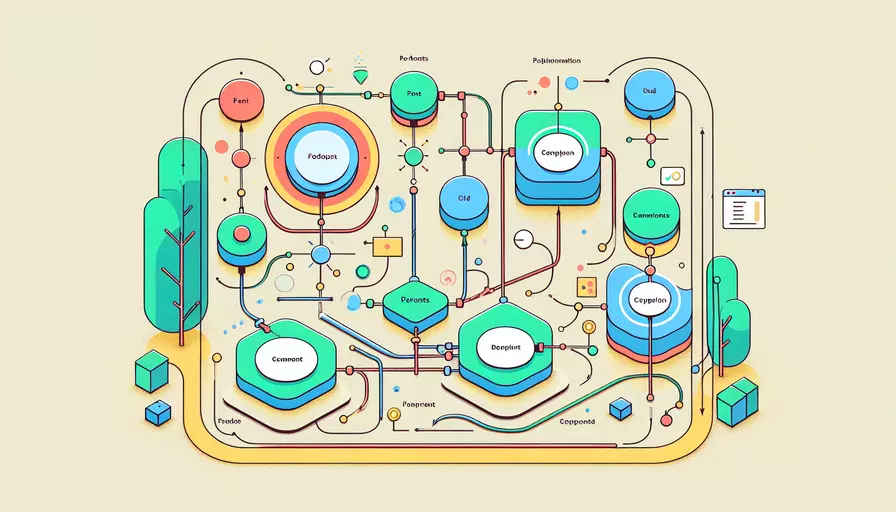
Vue的父子组件通信主要通过以下3种方式:1、props;2、$emit;3、ref。这三种方法各有其适用的场景和优缺点,具体使用哪种方式取决于具体需求和组件间的关系。
一、PROPS
1. 使用场景
Props是Vue中最常见的父子组件通信方式,通常用于父组件向子组件传递数据。父组件通过在子组件的标签上定义属性来传递数据,子组件通过props选项接收这些数据。
2. 实现步骤
-
父组件
<template><div>
<child-component :message="parentMessage"></child-component>
</div>
</template>
<script>
import ChildComponent from './ChildComponent.vue';
export default {
data() {
return {
parentMessage: 'Hello from Parent'
};
},
components: {
ChildComponent
}
};
</script>
-
子组件
<template><div>
<p>{{ message }}</p>
</div>
</template>
<script>
export default {
props: ['message']
};
</script>
3. 优缺点
-
优点
- 简单直观,易于理解和使用。
- 数据流单向,易于维护和调试。
-
缺点
- 只能用于父组件向子组件传递数据,无法反向传递。
- 对于深层嵌套的组件树,传递数据会变得繁琐。
二、$EMIT
1. 使用场景
$emit用于子组件向父组件发送消息或事件。通常在子组件需要通知父组件某些操作或数据更新时使用。
2. 实现步骤
-
子组件
<template><div>
<button @click="notifyParent">Click Me</button>
</div>
</template>
<script>
export default {
methods: {
notifyParent() {
this.$emit('childEvent', 'Hello from Child');
}
}
};
</script>
-
父组件
<template><div>
<child-component @childEvent="handleChildEvent"></child-component>
</div>
</template>
<script>
import ChildComponent from './ChildComponent.vue';
export default {
methods: {
handleChildEvent(message) {
console.log(message);
}
},
components: {
ChildComponent
}
};
</script>
3. 优缺点
-
优点
- 灵活,子组件可以自由地向父组件传递消息。
- 有助于解耦组件,子组件无需知道父组件的内部实现。
-
缺点
- 事件处理代码可能会分散在父组件中,增加代码复杂性。
- 依赖于事件名称,容易出错。
三、REF
1. 使用场景
ref用于在父组件中直接访问子组件实例。适用于需要调用子组件的方法或访问子组件的内部状态的情况。
2. 实现步骤
-
父组件
<template><div>
<child-component ref="child"></child-component>
<button @click="callChildMethod">Call Child Method</button>
</div>
</template>
<script>
import ChildComponent from './ChildComponent.vue';
export default {
methods: {
callChildMethod() {
this.$refs.child.childMethod();
}
},
components: {
ChildComponent
}
};
</script>
-
子组件
<template><div>
<p>Child Component</p>
</div>
</template>
<script>
export default {
methods: {
childMethod() {
console.log('Child method called');
}
}
};
</script>
3. 优缺点
-
优点
- 直接访问子组件实例,简单直接。
- 适用于需要调用子组件方法的场景。
-
缺点
- 可能导致组件间的高耦合,不利于组件的重用和维护。
- 不适用于跨多层组件的通信。
总结
在Vue中,父子组件通信的方式主要有3种:1、通过props进行单向数据流传递;2、通过$emit方法让子组件向父组件发送事件;3、通过ref直接访问子组件实例。每种方式都有其适用的场景和优缺点。选择合适的通信方式,可以提高代码的可维护性和可读性。建议在实际项目中,根据具体需求和组件关系,灵活运用这几种方法,确保组件间的通信高效且清晰。
进一步建议:
- 明确数据流向:尽量保持数据流单向,减少不必要的双向绑定,提升代码的可维护性。
- 模块化组件:尽量将组件设计得模块化和独立,减少组件间的耦合。
- 使用Vuex:对于复杂的组件间通信,可以考虑使用Vuex进行全局状态管理。
相关问答FAQs:
1. Vue如何实现父子组件之间的通信?
在Vue中,父组件和子组件之间的通信可以通过props和$emit来实现。父组件通过props向子组件传递数据,而子组件通过$emit触发事件来通知父组件。
首先,在父组件中定义一个属性,并将其作为props传递给子组件。在子组件中,通过props接收父组件传递的数据。这样父组件就可以向子组件传递数据了。
例如,在父组件中定义一个名为message的属性:
<template>
<div>
<child-component :message="message"></child-component>
</div>
</template>
<script>
export default {
data() {
return {
message: 'Hello from parent component!'
};
}
};
</script>
然后,在子组件中通过props接收父组件传递的数据:
<template>
<div>
<p>{{ message }}</p>
</div>
</template>
<script>
export default {
props: {
message: {
type: String,
required: true
}
}
};
</script>
这样,父组件就可以向子组件传递数据了。
其次,子组件可以通过$emit触发事件来通知父组件。在子组件中定义一个方法,并在需要的时候触发该方法。父组件通过在子组件上监听该事件来接收通知。
例如,在子组件中定义一个名为notify的方法:
<template>
<div>
<button @click="notify">Notify parent component</button>
</div>
</template>
<script>
export default {
methods: {
notify() {
this.$emit('notify-parent');
}
}
};
</script>
然后,在父组件中监听子组件的事件:
<template>
<div>
<child-component @notify-parent="handleNotify"></child-component>
</div>
</template>
<script>
export default {
methods: {
handleNotify() {
console.log('Received notification from child component!');
}
}
};
</script>
这样,子组件就可以通过$emit触发事件来通知父组件了。
2. 如何在Vue中实现兄弟组件之间的通信?
在Vue中,兄弟组件之间的通信可以通过一个共享的父组件来实现。父组件可以作为一个中间人,将数据传递给需要通信的兄弟组件。
首先,在父组件中定义一个数据,在需要通信的兄弟组件中通过props接收这个数据。然后,在需要改变这个数据的组件中通过$emit触发事件,将改变后的数据传递给父组件。最后,父组件通过props将改变后的数据传递给另一个兄弟组件。
例如,在父组件中定义一个名为sharedData的数据:
<template>
<div>
<first-component :shared-data="sharedData"></first-component>
<second-component :shared-data="sharedData"></second-component>
</div>
</template>
<script>
export default {
data() {
return {
sharedData: 'Hello from parent component!'
};
}
};
</script>
然后,在需要改变sharedData的组件中通过$emit触发事件:
<template>
<div>
<button @click="changeData">Change shared data</button>
</div>
</template>
<script>
export default {
methods: {
changeData() {
this.$emit('change-shared-data', 'New shared data');
}
}
};
</script>
最后,在父组件中监听change-shared-data事件,并将改变后的数据传递给另一个兄弟组件:
<template>
<div>
<first-component :shared-data="sharedData" @change-shared-data="handleChangeSharedData"></first-component>
<second-component :shared-data="sharedData"></second-component>
</div>
</template>
<script>
export default {
data() {
return {
sharedData: 'Hello from parent component!'
};
},
methods: {
handleChangeSharedData(newData) {
this.sharedData = newData;
}
}
};
</script>
这样,兄弟组件之间就可以通过一个共享的父组件进行通信了。
3. 如何在Vue中实现任意组件之间的通信?
在Vue中,任意组件之间的通信可以通过一个全局事件总线来实现。全局事件总线是一个空的Vue实例,可以用来触发和监听事件。
首先,创建一个全局事件总线:
import Vue from 'vue';
export const eventBus = new Vue();
然后,在需要通信的组件中,通过eventBus.$emit触发事件,并传递需要传递的数据:
<template>
<div>
<button @click="notify">Notify other components</button>
</div>
</template>
<script>
import { eventBus } from './eventBus';
export default {
methods: {
notify() {
eventBus.$emit('notify-components', 'Hello from component!');
}
}
};
</script>
最后,在需要接收通知的组件中,通过eventBus.$on监听事件,并处理接收到的数据:
<template>
<div>
<p>{{ message }}</p>
</div>
</template>
<script>
import { eventBus } from './eventBus';
export default {
data() {
return {
message: ''
};
},
created() {
eventBus.$on('notify-components', (data) => {
this.message = data;
});
}
};
</script>
这样,任意组件之间就可以通过全局事件总线进行通信了。只要组件能够访问到全局事件总线,就可以触发和监听事件。
文章标题:vue如何通信父子组件,发布者:worktile,转载请注明出处:https://worktile.com/kb/p/3625420

 微信扫一扫
微信扫一扫  支付宝扫一扫
支付宝扫一扫 